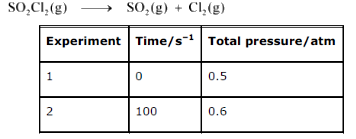The following data were obtained for the adsorption of carbon monoxide gas on 3.022 g of charcoal at 0∘C and 1 atm pressure. Verify that the data obey the Langmuir monolyer adsorption isotherm. Also calculate the constant K and the volume (v) corresponding to complete surface coverege
P(toor):100200300400500600v(cm3):10.218.625.531.436.941.6
According to one of the forms of Langmuir adsorption isotherm
Pv=Pvmono+1Kmono ...(i)
where v is the volume of rthe gas adsorbed on the surface at pressure P and vmono is the volume required for complete coverage of the surface by monolyer.
Thus, a plot of Pv versus P should be linear to verify Langmuir equation.
From the given data, we calculate P/v corresponding to each value of P. Thus.

On plotting Pv versus P, we get a straight line plot. This verifies Langumuir monolyer adsorption isotherm. Further, from the plot, we get
Slope =0.009and Intercept =9.0
From eqn. (i). plot of P/v vs P is linear with slope =1vmonoand intercept =1Kvmono
∴1vmono=0.009orvmono=111cm3
1Kvmono=9.0orK=19.0×vmono=1(9.0torr cm−3)(111cm3)=10−3torr−1
Topper's Solved these Questions
- SURFACE CHEMISTRY BOOK - PRADEEPCHAPTER - SURFACE CHEMISTRY EXERCISE - TEST YOUR GRIP (MULTIPLE CHOICE QUESTIONS)
14 Videos
- SURFACE CHEMISTRY BOOK - PRADEEPCHAPTER - SURFACE CHEMISTRY EXERCISE - FILL IN THE BLANKS
38 Videos
- SURFACE CHEMISTRY BOOK - PRADEEPCHAPTER - SURFACE CHEMISTRY EXERCISE - PROBLEM FOR PRACTICE
1 Videos
- SOME BASIC CONCEPTS OF CHEMISTRYBOOK - PRADEEPCHAPTER - SOME BASIC CONCEPTS OF CHEMISTRYEXERCISE - Competition (FOCUS) JEE (Main and Advanced)/Medical Entrance SPECIAL (VIII. Assertion-Reason Type Questions)(Type II)
13 Videos
Similar Questions
The following data were obtained for the adsorptionof carbon monoxide gas on 3.0 g of charcoal at 0∘C and1 atm pressure.
Pressure (mmHg)200400Volume of gas adsorved,x18.631.4(reduced to STP)
Calculate the values of the constants k and n using Freundlich adsorption equation.
View SolutionThe following data were obtained for the adsorption of CO on 3 g of charcoal at 0∘C
Pressuer (mm) : 180 540
Volume of gas absorbed in cc raduced to STP : 16.5 38.1
Calculate the values of the constants k and n used in Freundlich equation.
View Solution
Knowledge Check
The following graph is obtained for the adsorption of an ideal gas at charcoal surface, obeying Freundlich's isotherm. The value of xm at P=32 atm, is:
(#3GRB_PHY_CHM_P2_V03_QB_C13_E01_110_Q01.png" width="80%">A10B4C1D0.6At 1 atm and 273 K the volume of nitrogen gas required to cover a sample of silica gel, assuming Langmuir monolayer adsorption , is found to be 1.30cm3g−1 of the gel. The area occupied by a nitrogen molecule is 0.16nm2. Find out the no. of surface sites occupied per molecule of N2.
A5.568m2g−1B3.48m2g−1C1.6m2g−1DNone of theseThe following data were obtained during the first order thermal
decomposition of SO2Cl2 at a constant volume SO2Cl2(g)→SO2(g)+Cl2(g)

Calculate the rate of the reaction when total pressure is 0.65 atmA0.35atmS−1B2.235×10−3atmS−1C7.8×10−4atms−1D1.55×10−4atmS−1
At 1 atm and 273 K the volume of nitrogen gas required to cover a sample of silica gel, assuming Langmuir monolayer adsorption , is found to be 1.30cm3g−1 of the gel. The area occupied by a nitrogen molecule is 0.16nm2. Find out the no. of surface sites occupied per molecule of N2.
View SolutionThe following data were obtained during the first order thermal decomposition of SO2Cl2 at constant volume :
ExperimentTime (s)Total Pressure (atm)100.321000.5
Calculate rate constant
[Given : log 6 = 0.7782, log 3 = 0.4771]
View SolutionThe following data were obtained during the first order thermal decomposition of SO2Cl2 at constant volume :
ExperimentTime (s)Total Pressure (atm)100.321000.5
Calculate rate constant
[Given : log 6 = 0.7782, log 3 = 0.4771]
View SolutionThe following data were obtained during the first order thermal decomposition of N2O5 (g) at constant volume:
2N2O5(g)→2N2O4(g)+O2(g)
(S.no,Time,Total Pressure / atm),(1,0,0,5),(2,100,0.512)
Calculate the rate constant.
View SolutionWhen 22.5 J was added as heat to a particular ideal gas, the volume of the gas changed from 50.0 cm3 to 100 cm3 while the pressure remained at 1.00 atm. (a) By how much did the internal energy of the gas change? If the quantity of gas present was 2.00×10−3mol, find (b)Cp and (c) Cv
View Solution
